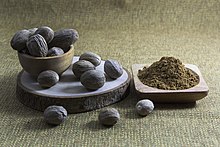**1. Nutmeg and Mace Production:**
– Nutmeg is made by grinding the seed of the nutmeg tree into powder, while mace is derived from the reddish seed covering.
– Nutmeg seeds are dried for 15 to 30 weeks, while mace’s aril is dried for 10 to 14 days.
– Nutmeg trees are primarily cultivated in Indonesia, Malaysia, the Caribbean, and southern India.
– The global nutmeg production in 2019 was 142,000 tonnes, with Indonesia, Guatemala, and India leading with 85% of the world total.
– The Dutch East India Company established the nutmeg plantation system in the 17th century.
**2. Culinary Uses and Botany:**
– Nutmeg and mace have distinct flavors but similar sensory qualities.
– Nutmeg is used in various dishes like baked goods, confections, puddings, meats, and sauces.
– Nutmeg is commonly found in Indian and European cuisines, as well as in Italian dishes like meat-filled dumplings and meatloaf.
– Nutmeg trees are dioecious and propagated sexually and asexually, with grafting being the preferred method due to inconsistent yields.
– The first harvest of nutmeg occurs 7–9 years after planting, reaching full production after 20 years.
**3. Essential Oil and Toxicity:**
– Nutmeg essential oil is obtained through steam distillation and contains compounds like D-pinene, limonene, and safrol.
– Myristicin in nutmeg oil is toxic in excess and can cause adverse effects like nausea and delirium.
– The oil is used in perfumery, pharmaceuticals, food flavoring, toothpaste, and cough syrups.
– Nutmeg oil leaves no particles in food and can be used as a substitute for ground nutmeg.
– Nutmeg has no proven medicinal value, but ingesting large doses can have psychoactive effects.
**4. Historical Significance:**
– Nutmeg has a rich history, with evidence of its use dating back to Pulau Ai in the Banda Islands.
– The Banda Islands were the sole nutmeg source until the mid-19th century, with the Dutch East India Company establishing a monopoly.
– Nutmeg’s history includes battles for control between the Portuguese, Dutch, and British during the colonial era.
– Connecticut’s nickname, the ‘Nutmeg State,’ may relate to historical fraud involving nutmeg.
– Nutmeg has been culturally significant in various regions and has been used for culinary and medicinal purposes for centuries.
**5. Toxicity and Research:**
– Nutmeg intoxication can have adverse effects, with symptoms like hallucinations and tachycardia reported in poisoning cases.
– Myristicin in nutmeg can cause various toxic effects, and its consumption in large amounts during pregnancy can lead to premature labor.
– Nutmeg can be toxic to pets if consumed excessively due to its poisonous properties.
– Research on nutmeg toxicity, chemical composition, and poisoning has been published in journals like the Journal of Medical Toxicology and the Journal of Food Science.
– Studies have reviewed the toxicity of myristicin in nutmeg, highlighting its potential dangers.
Nutmeg is the seed, or the ground spice derived from that seed, of several tree species of the genus Myristica; fragrant nutmeg or true nutmeg (M. fragrans) is a dark-leaved evergreen tree cultivated for two spices derived from its fruit: nutmeg, from its seed, and mace, from the seed covering. It is also a commercial source of nutmeg essential oil and nutmeg butter. Indonesia is the main producer of nutmeg and mace, and the true nutmeg tree is native to its islands.
 | |
| Type | Seed and ground spice |
|---|---|
If consumed in amounts exceeding its typical use as a spice, nutmeg powder may produce allergic reactions, cause contact dermatitis, or have psychoactive effects. Although used in traditional medicine for treating various disorders, nutmeg has no scientifically confirmed medicinal value.
Conifers of the genus Torreya, commonly known as the nutmeg yews, have edible seeds of similar appearance, but are not closely related to M. fragrans, and are not used as a spice.
